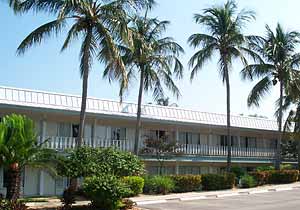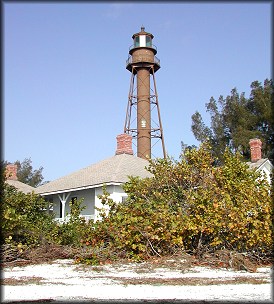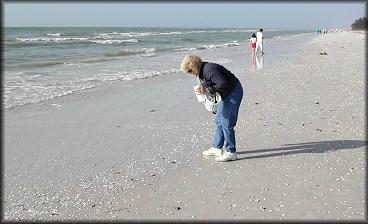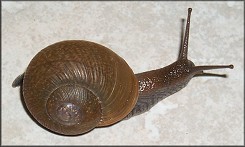| Field Trip To Sanibel Shell Fair And Show |
| By Bill Frank |
 The weekend of March 1st, eleven members of the Jacksonville Shell Club were in attendance at the 65th Annual Sanibel Shell Fair and Show held at the Sanibel Community House on Sanibel Island from March 1st-3rd. Eight club members (Barbara Moon, Selma Hutchison, Anna Bechak, Bill and Betsy Lyerly, Bill Frank, Pam Rice, and Carol Rischel) left Jacksonville early Friday morning for the six and a half hour drive to the island while the remaining club members (Ruth and Frank Abramson who judged the artistic exhibits and Gertrude Moller who entered an artistic exhibit) had traveled to the island earlier in the week. Headquarters for the Friday travelers was the Shell Point Guest House at the "upscale" Shell Point Retirement Community conveniently located just north of the Sanibel Causeway. Beautifully landscaped grounds, restricted access, extremely friendly people, and reasonable lodging prices make the facilities at Shell Point hard to beat. Upon arrival at Shell Point, each group seemed to have their own agenda. Some visited the shops, others couldn’t wait to actually shell the famous Sanibel Beaches, and others managed both during the limited hours available on Friday afternoon. It should be mentioned that Friday was the first day that the recently enacted total ban on live shell collecting was in effect in Lee County (see article on page 2.). Saturday morning early it was again back to the island for more shelling, shopping and a first visit to the Shell Fair and Show, which as usual, had some impressive exhibits. By prior arrangement, we met Dr. Jose’ Leal (Bailey-Matthews Shell Museum Director) at the show who had agreed to give the group a "behind the scenes" tour of the museum’s work area and collection. The tour was then scheduled for 1:30 PM, which allowed a couple hours of "island roaming" and shelling. Four of us then drove up to the Blind Pass Bridge where Dr. Leal had been earlier in the day and reported seeing shells being washed in near the jetty. However, he also warned of the noxious "Red Tide."
It was then off to the Bailey-Matthews Shell Museum where we all assembled for the guided tour by Dr. Leal. We were also accompanied on the tour by show judges Roger Portell and John Chessler. It was a unique and interesting experience which was enjoyed by all, and we not only owe Dr. Leal a debt of gratitude for taking time out of his busy schedule to accommodate us, but also to the museum volunteers who extended us every courtesy. One even offered to share her afternoon snack with your editor (who had missed both breakfast and lunch). Following the tour, the group split up again for more shelling, shopping, or return to the guesthouse. Later the group reconstituted at the local Perkins Restaurant for evening’s repast. Unlike the previous night (Friday) when several of us visited the same restaurant, there were only a "lot of people" vs. "virtually everyone in Ft. Myers." It was then back to Shell Point for some rest and relaxation.
Using a strong flashlight, on Friday evening your editor spotted a suitable live Melongena corona (Gmelin, 1791) [Crown Conch] in the "lagoon" at Shell Point. The only rub was that in order to retrieve it for photography, one must drop five feet into the water from the top of a five-foot, strait-sided concrete wall. Getting out again was not a given without a lot of upper body strength. Fortunately, gravity was defied this date but unfortunately the specimen was lethargic and not a suitable photography candidate. The next evening (Saturday night following the repast at Perkins Restaurant), another more active Crown Conch specimen was seen at the same location. However, a middle-aged person can defy gravity only so often so it was a pass at this time and off to other "safer" location on San Carlos Bay where the winds raged and the seas surged. Nothing new was found but a definite "mooing sound" was heard during the solitary late night visit. Initially it was thought that this sound was imagined, but about three minutes later, it was heard again. A quick survey of the rough seas with the flashlight revealed nothing out of the ordinary. Eerie it was to be sure – a Manatee maybe? So it was back to the room where almost immediately the phone rang. It was Pam who said that she and Carol had been at the Shell Point Marina, nonchalantly walking along, when something large jumped into the water severely startling them (read screams), and they wanted me to accompany them to the marina with my flashlight to see if it could be ascertained exactly what it was (creature from the black lagoon maybe). Seeing an opportunity, it was iterated that my cooperation would requite them accompanying me to the Shell Point Lagoon to "rescue" the Crown Conch and me if I couldn’t climb out of the lagoon. It turns out that their help wasn’t necessary but it was nice to have someone there just in case. Spending a windy night in the water wasn’t too appealing. It was then off to the marina where the earlier event couldn’t be replicated despite Carol’s marching up-and-down the boardwalk, stomping her feet, as Pam and I observed with the flashlight from an offshore finger-pier. As a somewhat disinterested observer, I suspect the following in order of probabilities:
The next morning, again, it was again every group for themselves. Some left for home while others returned to the island for more shopping/shelling. Overall, it was an interesting and busy trip. But when all’s said and done, "There’s no place like home!" |
 Upon our arrival at Blind Pass and exiting the car, the "Red Tide" was very
noticeable as evidenced by our coughing, sneezing, and a general burning in the
throat. There were in fact plenty of craft type shells in the drift (and plenty
of people raking through them) but the Red Tide exacerbated by the high winds
and tide, made perusing them less than a delightful experience. Since large
dunes now close the pass, shelling away from the beach was not productive and
the only live species seen were
Lampanella minima (Gmelin, 1791) [West
Indian False Cerith] by the millions and a handful of Littoraria
angulifera (Lamarck, 1822) [Mangrove Periwinkle].
Upon our arrival at Blind Pass and exiting the car, the "Red Tide" was very
noticeable as evidenced by our coughing, sneezing, and a general burning in the
throat. There were in fact plenty of craft type shells in the drift (and plenty
of people raking through them) but the Red Tide exacerbated by the high winds
and tide, made perusing them less than a delightful experience. Since large
dunes now close the pass, shelling away from the beach was not productive and
the only live species seen were
Lampanella minima (Gmelin, 1791) [West
Indian False Cerith] by the millions and a handful of Littoraria
angulifera (Lamarck, 1822) [Mangrove Periwinkle]. To your editor, one of the selling points of the trip
was the possibility of photographing some new live specimens for the
club’s web pages. However, a general shortage of available time on such a short
trip (as well as shelling locations and live shells) made this task quite
difficult – not to mention the persistent high winds and a tide which appeared
to never go out.
To your editor, one of the selling points of the trip
was the possibility of photographing some new live specimens for the
club’s web pages. However, a general shortage of available time on such a short
trip (as well as shelling locations and live shells) made this task quite
difficult – not to mention the persistent high winds and a tide which appeared
to never go out. As a bonus, as we left the marina, a large land snail
was found crawling across the sidewalk that turned out to be a Zachrysia
provisoria (L. Pfeiffer, 1858). Encouraged by this
surprise find, a full island search was then conducted for other terrestrials
which did yield an unidentified snake lying in the middle of the sidewalk, but
nothing else. It would appear that snake collecting at Shell Point could be
quite good as it was the second encountered during the my late night roaming –
and I wasn’t even looking for them.
As a bonus, as we left the marina, a large land snail
was found crawling across the sidewalk that turned out to be a Zachrysia
provisoria (L. Pfeiffer, 1858). Encouraged by this
surprise find, a full island search was then conducted for other terrestrials
which did yield an unidentified snake lying in the middle of the sidewalk, but
nothing else. It would appear that snake collecting at Shell Point could be
quite good as it was the second encountered during the my late night roaming –
and I wasn’t even looking for them.